INTRODUCTION
It is a running joke that politicians lie. However, in general we expect those in positions of authority to inform the public truthfully about what is happening. In the case of the people we elect, we expect that they will be honest, and for most of the nation’s history, Americans usually believed what their presidents told them. That is not the case today. Now, our first instinct is to question and we and the media are on the lookout for lies. Some newspapers even keep a running log of each time a president says something that is even partially untrue. The Washington Post’s famous fact checkers award Pinocchios to politicians the way reviewers give stars to movies.
How did this change happen? How is it that we came to be so distrusting? Furthermore, does our mistrust extend to other leaders, such as CEOs, generals, superintendents, principals, or even teachers?
This shift happened during the 1970s. A simple chart showing the percentage of people who trust the president over time falls off dramatically during this decade, and an exploration of the events of those years can give us a good idea as to why this shift happened. In the 1970s, leakers revealed that a series of presidents had been lying about the Vietnam War, a president resigned in disgrace after participating in a criminal conspiracy, and all three presidents during the decade failed to turn around a struggling economy.
That brings us to our question. The 1970s certainly proved that sometimes our presidents are untrustworthy, or at least unable to achieve the goals we wish they could. But does that mean we can’t trust our leaders in general, or just that we should expect them to earn our trust?
What do you think? Can we trust our nation’s leaders?
THE PENTAGON PAPERS
In 1967, Secretary of Defense Robert McNamara created a special study group charged with writing an “encyclopedic history of the Vietnam War.” McNamara claimed that he wanted to leave a written record for historians, to prevent policy errors in future administrations, but he neglected to inform either President Lyndon Johnson or Secretary of State Dean Rusk about the study.
Instead of using existing Defense Department historians, McNamara assigned close aides. Thirty-six analysts worked on the study. They largely used existing files in the Office of the Secretary of Defense in order to keep the study secret, and conducted no interviews or consultations with the armed forces, with the White House, or with other federal agencies.
McNamara left the Defense Department in February 1968, and his successor Clark Clifford received the finished study on January 15, 1969, five days before President Richard Nixon’s inauguration, although Clifford claimed he never read it. The study comprised 3,000 pages of historical analysis and 4,000 pages of original government documents in 47 volumes, and was classified as “Top Secret – Sensitive.”
But the report did not remain secret. One of the analysts who had access to the report, Daniel Ellsberg opposed the war, and he and his friend Anthony Russo photocopied the study in October 1969 intending to disclose it. Ellsberg said the documents “demonstrated unconstitutional behavior by a succession of presidents, the violation of their oath and the violation of the oath of every one of their subordinates.”
In February 1971, Ellsberg discussed the study with New York Times reporter Neil Sheehan, and gave 43 of the volumes to him in March. Before publication, The New York Times sought legal advice. The paper’s regular lawyers, Lord Day & Lord, advised against publication, but in-house counsel James Goodale prevailed with his argument that the press had a First Amendment right to publish information significant to the people’s understanding of their government’s policy.
The New York Times began publishing excerpts on June 13, 1971, in a series titled “Vietnam Archive: Pentagon Study Traces Three Decades of Growing US Involvement.” The study was dubbed The Pentagon Papers during the resulting media publicity.
The Pentagon Papers revealed that four presidents – Truman, Eisenhower, Kennedy, and Johnson – had misled the public regarding their intentions in Vietnam. For example, the Eisenhower Administration actively worked against the Geneva Accords. The Kennedy administration knew of plans to overthrow South Vietnamese leader Ngo Dinh Diem before his death in the November 1963 coup. President Johnson had decided to expand the war while promising, “we seek no wider war” during his 1964 presidential campaign, including plans to bomb North Vietnam well before the 1964 Election. President Johnson had been outspoken against doing so during the election and claimed that his opponent Barry Goldwater was the one that wanted to bomb North Vietnam, but in the end, Johnson authorized the bombing of Cambodia and Laos, and coastal raids on North Vietnam, none of which had been reported by the American media.
President Nixon at first planned to do nothing about publication of the study since it embarrassed the Johnson and Kennedy administrations rather than his own, but Henry Kissinger convinced the president that not opposing the publication might encourage future leaks that would hurt Nixon. Government lawyers argued that Ellsberg and Russo were guilty of violating the Espionage Act of 1917 because they had no authority to publish classified documents. After failing to persuade the New York Times to voluntarily cease publication, Attorney General John Mitchell and Nixon obtained a federal court injunction forcing the Times to cease publication after three articles. The newspaper appealed the injunction, and the case New York Times Co. v. United States quickly rose through the legal system to the Supreme Court.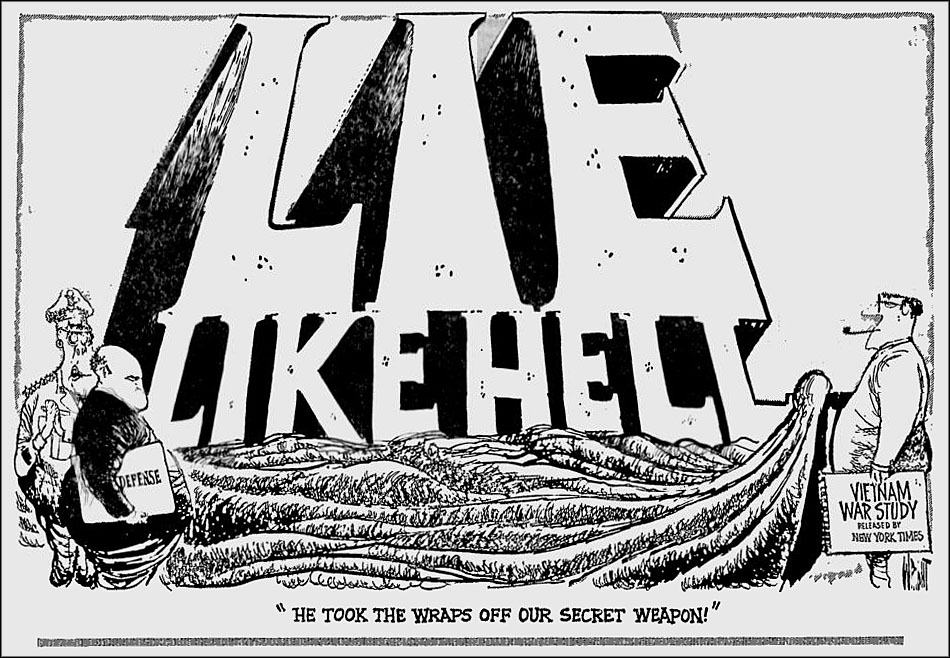 Primary Source: Editorial Cartoon
Primary Source: Editorial Cartoon
A 1971 cartoon by Don Wright panning the military and government for their deception during the Vietnam War.
On June 18, 1971, The Washington Post, which had also received portions of the documents from Ellsberg, began publishing its own series of articles based upon the Pentagon Papers. That same day, Assistant U.S. Attorney General William Rehnquist asked the Post to cease publication. After the newspaper’s owners refused, Rehnquist sought an injunction in district court. Judge Murray Gurfein declined to issue such an injunction, writing that, “the security of the Nation is not at the ramparts alone. Security also lies in the value of our free institutions. A cantankerous press, an obstinate press, a ubiquitous press must be suffered by those in authority to preserve the even greater values of freedom of expression and the right of the people to know.” The government appealed that decision, and on June 26, the Supreme Court agreed to hear it jointly with the New York Times case. In the meantime, fifteen other newspapers received copies of the study and began publishing it.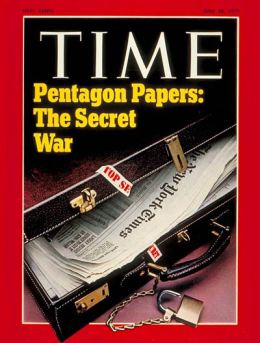 Primary Source: Magazine Cover
Primary Source: Magazine Cover
Many news sources published stories about the Pentagon Papers, including Time Magazine.
On June 30, 1971, the Supreme Court decided, 6-3, that the government failed to meet the heavy burden of proof required to obtain a prior restraint injunction. The nine justices wrote nine opinions disagreeing on significant, substantive matters, but the essential takeaways from the case were clear.
In the words of Justice Black, “Only a free and unrestrained press can effectively expose deception in government. And paramount among the responsibilities of a free press is the duty to prevent any part of the government from deceiving the people and sending them off to distant lands to die of foreign fevers and foreign shot and shell.”
The outcome was a major victory for newspapers, and the media in general. Even today, the New York Times Co. v. United States case protects the right of the press to report what government officials are doing, even if those officials don’t want the public to know.
Ellsberg himself surrendered to authorities and admitted that he had given the papers to the press stating, “I felt that as an American citizen, as a responsible citizen, I could no longer cooperate in concealing this information from the American public. I did this clearly at my own jeopardy and I am prepared to answer to all the consequences of this decision.” He was indicted by a grand jury in Los Angeles on charges of stealing and holding secret documents. But the Nixon Administration botched the case. In their paranoia about preventing future leaks, Nixon’s henchmen, called the Plumbers, had decided to humiliate Ellsberg and had illegally broken into the office of Ellsberg’s psychiatrist in a failed attempt to steal embarrassing files.
Federal District Judge William Matthew Byrne, Jr. declared a mistrial and dismissed all charges against Ellsberg and his partner Russo on May 11, 1973, after it was revealed that agents acting on the orders of the Nixon administration had approached the trial judge and offered to make him director of the FBI. Judge Byrne ruled, “the totality of the circumstances of this case… offend a sense of justice.” Ellsberg and Russo were freed and the public began to think that Nixon was no more honest than his predecessors.
On May 4, 2011, the National Archives and Records Administration announced that the complete Pentagon Papers would be declassified and released. Today, anyone can download and read the Papers from the Archive’s website.
NIXON’S REELECTION
After the chaotic convention in Chicago in 1968, the Democratic Party redesigned its procedure for selecting its presidential candidate. The new rules, set by a commission led by George McGovern, a senator from South Dakota, awarded delegates based on a candidate’s performance in state primaries. As a result, a candidate who won no primaries could not receive the party’s nomination as Hubert Humphrey had controversially done in Chicago.
The new system gave a greater voice to people who voted in the primaries and reduced the influence of party leaders and power brokers who might manipulate the nominating process at the convention itself. It also led to a more inclusive political environment. In 1972, Shirley Chisholm, a member of the House of Representatives from New York became the first African-American and first woman to win official support for a major party nomination when she garnered 156 votes on the first ballot.
Eventually, the nomination went to George McGovern, a strong opponent of the Vietnam War. However, many Democrats refused to support his campaign. Working and middle class voters turned against him after allegations that he supported abortion and the decriminalization of drug use. McGovern’s initial support of vice presidential candidate Thomas Eagleton in the face of revelations that Eagleton had undergone electroshock treatment for depression, followed by his withdrawal of that support and acceptance of Eagleton’s resignation, also made McGovern look indecisive and disorganized.
Nixon and the Republicans held a strong lead in public opinion from the start. Nixon’s foreign policy successes, including his visit to China and a healthy economy bolstered his reputation. To increase their advantage, Republicans attempted to paint McGovern as a radical leftist who favored amnesty for draft dodgers. In the Electoral College, McGovern carried only liberal Massachusetts and Washington, DC. Nixon won a decisive victory of 520 electoral votes to McGovern’s 17. One Democrat described his role in McGovern’s campaign as “recreation director on the Titanic.” It was one of the most lopsided victories in American presidential history. Unfortunately for Nixon, the seeds of his downfall were already sown.
THE WATERGATE BREAK-IN
During the presidential campaign, the Committee to Re-Elect the President (CREEP), the fundraising arm of the Nixon Campaign, decided to play “dirty tricks” on Nixon’s opponents. Before the New Hampshire democratic primary, they released a forged letter supposedly written by democratic-hopeful Edmund Muskie in which he insulted French Canadians, one of the state’s largest ethnic groups. Men were assigned to spy on both McGovern and democratic hopeful Senator Edward Kennedy. Men pretending to work for the campaigns of Nixon’s Democratic opponents contacted vendors in various states to rent or purchase materials for rallies. The rallies were never held, of course, and democratic politicians were accused of failing to pay their bills. CREEP’s most notorious operation, however, was its break-in at the offices of the Democratic National Committee (DNC) in the Watergate office complex in Washington, DC.
According to a plan originally proposed by CREEP’s general counsel and White House aid G. Gordon Liddy, five men were to break in to the offices of the DNC, photograph documents, and wiretap telephones. The break-in went badly. The burglars were discovered by a security guard, arrested by the police, tried and either pled guilty or were convicted.
Criminal wrongdoing in an election is never good for a politician, but even from the beginning, James Neal, the prosecutor on the case, didn’t believe Nixon had any knowledge of what the conspirators were planning. The problem for Nixon, was his paranoia. Nixon always believed that his political opponents were going to get the better of him, and that his supporters might turn against him. He had even ordered the creation of an “enemies list” of people who he hated and were not allowed to visit the White House or speak with him.
The Watergate break-in was exactly the sort of problem Nixon was terrified of, and although Nixon himself was innocent, his efforts to hide the entire operation brought down his presidency.
In the weeks following the Watergate break-in, Bob Woodward and Carl Bernstein, young reporters for The Washington Post, received information from several anonymous sources, including one known to them only as “Deep Throat,” that led them to realize that people in the White House were trying to cover up the truth about the break-in. While most of the press focused on other events, Woodward and Bernstein continued to dig and publish their findings.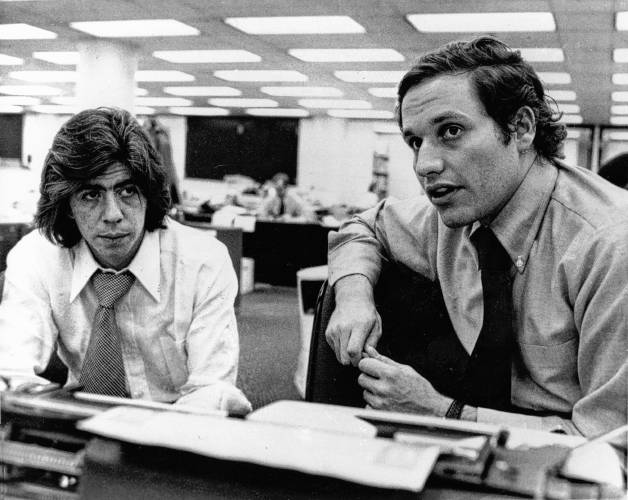 Primary Source: Photograph
Primary Source: Photograph
Reporters Carl Bernstein and Bob Woodward in the newsroom of the Washington Post.
What Woodward and Bernstein found led the Senate to appoint a special committee to investigate the Watergate affair. Throughout the spring and the long, hot summer of 1973, Americans sat glued to their television screens, as the major networks took turns broadcasting the Senate hearings. One by one, disgraced former members of the administration confessed, or denied, their role in the Watergate scandal. The top lawyer at the White House, John Dean testified that Nixon was involved in the conspiracy, allegations the president denied. In March 1974, the President’s Chief of Staff, H.R. Haldeman, top aid John Ehrlichman, and John Mitchell, the head of Nixon’s reelection campaign were indicted and charged with conspiracy.
Nixon fired Haldeman, Ehrlichman and Dean. In an effort to show that he was innocent, he authorized the appointment of a special prosecutor, Archibald Cox to investigate the entire affair.
THE END OF NIXON’S PRESIDENCY
Without evidence clearly implicating the president, the investigation might have ended if not for the testimony of Alexander Butterfield, a low-ranking member of the administration. Butterfield was asked if there were any recordings of Nixon himself. In fact, Butterfield had helped Nixon install a recording system that would turn on whenever anyone in the Oval Office spoke, or any time the president was on the phone. Nixon wanted the recordings for his personal use and kept them a secret because he thought his aids would not be candid if they knew they were being taped.
Cox and the Senate subpoenaed the tapes. Nixon, however, refused to hand them over, citing executive privilege, the right of the president to refuse certain subpoenas. When he offered to supply summaries of the conversations, Cox refused. On October 20, 1973, in an event that became known as the Saturday Night Massacre, Nixon ordered Attorney General Richardson to fire Cox. Richardson refused and resigned, as did Deputy Attorney General William Ruckelshaus when confronted with the same order. Control of the Justice Department then fell to Solicitor General Robert Bork, who complied with Nixon’s order.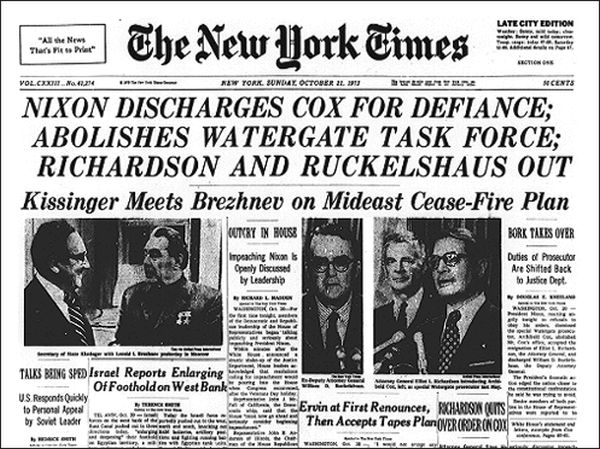 Primary Source: Newspaper
Primary Source: Newspaper
The front page of the New York Times the day after the Saturday Night Massacre.
The public was enraged by Nixon’s actions. It seemed as though the president had placed himself above the law. Telegrams flooded the White House. Nixon went on the defensive. At a press conference in November, he argued that he was innocent and that he wanted a full investigation, stating, “…in all of my years of public life, I have never obstructed justice. And I think, too, that I can say, that in my years of public life, that I welcome this kind of examination because people have got to know whether or not their president is a crook. Well, I’m not a crook.” It was a claim that would tarnish his legacy forever.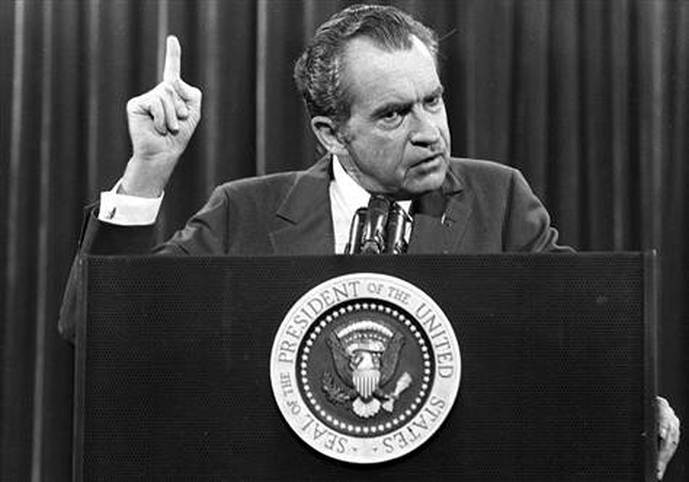 Primary Source: Photograph
Primary Source: Photograph
Nixon declares that his is “not a crook.”
When Nixon finally agreed to release transcripts of the tapes in April of 1974, he released only edited versions. In July, The Supreme Court ruled in United States v. Nixon that the president could not claim executive privilege and ordered him to hand over the unedited versions.
The tapes revealed several crucial conversations that took place between the President and his counsel, John Dean, and focused on the cover-up, in which Dean described it as a “cancer on the presidency.” The burglary team was being paid hush money for their silence and Dean noted that Nixon’s top aides were involved. In the end, Nixon himself gave orders on tape to pay off witnesses.
It was now clear that Nixon was personally involved in the cover-up. Perhaps worst of all, he had tried to obstruct justice by firing the special prosecutor and ordering his aids to pay hush money to people who knew what had happened.
The release of the tapes destroyed Nixon politically. The House of Representatives was ready to vote to impeach the president. On the night of August 7, 1974, the republican leaders of the House and Senate met with Nixon in the Oval Office to warn him that his support in Congress had all but disappeared. They told him that he would face certain impeachment when the House voted and that there were enough votes in the Senate to convict him.
Realizing that he had no chance of staying in office and that public opinion was not in his favor, Nixon decided to resign. On August 9, he left the White House in disgrace. Primary Source: Photograph
Primary Source: Photograph
Richard Nixon flashes his trademark V for victory one last time before boarding Marine One and leaving the White House after his resignation.
THE EFFECTS OF THE WATERGATE SCANDAL
It was indeed an unprecedented time. The new president, Gerald Ford was the first vice president chosen under the terms of the new 25th Amendment, which provides for the appointment of a vice president in the event the incumbent dies or resigns. Nixon had appointed Ford, a longtime representative from Michigan known for his honesty following the resignation of embattled vice president Spiro T. Agnew over a charge of failing to report income, a lenient charge since this income stemmed from bribes he had received as the governor of Maryland. Ford was also the first vice president to take office after a sitting president’s resignation, and the only chief executive never elected either president or vice president.
Ford understood that his most pressing task was to help the country move beyond the Watergate scandal. His declaration that “Our long national nightmare is over… our great Republic is a government of laws and not of men” was met with almost universal applause. But the nation’s goodwill evaporated when he granted Richard Nixon a full pardon. Ford thus prevented Nixon’s indictment for any crimes he may have committed in office and ended criminal investigations into his actions. The public reacted with suspicion and outrage. Many were convinced that the extent of Nixon’s wrongdoings would never been known and he would never be called to account. When Ford chose to run for the presidency in 1976, the pardon returned to haunt him.
Nixon’s resignation and Ford’s pardon did not make the Watergate scandal vanish. Instead, it fed a growing suspicion of government felt by many. The events of Vietnam and the release of the Pentagon Papers had already showed that the government could not be trusted to protect the interests of the people or tell them the truth. For many, Watergate confirmed these beliefs. Since Nixon’s resignation, Americans have shown a much greater reluctance to trust their presidents.
Today, the suffix gate attached to a word has come to mean a scandal, in politics or otherwise. News sources have reported on Apple’s Bendgate and Antennagate, the NFL’s Deflategate and Seatgate, and myriad wrongdoings of politicians dubbed Bridgegate, Travelgate, Emailgate, Nannygate and Strippergate, to name just a few.
THE IRAN HOSTAGE CRISIS
One of the most tragic events of the late 1970s was a result of American Cold War activities in the Middle East, and set the stage for a conflict that is ongoing. It also revealed the limitations of American military power. The military’s reputation had already been tarnished by the debacle in Vietnam, and Americans took out their frustration on their president. It all happened in Iran.
For years, the United States had supported the king, or shah of Iran as an anti-communist. The shah, Mohammad Reza Pahlavi had come to power during World War II and had worked hard in his thirty years in power to modernize his country. He promoted industrialization and rights for women. Unfortunately for the Shah and his supporters, a powerful conservative backlash was brewing among the Islamic clergy who believed the Shah’s policies ran counter to the teachings of the Quran. In 1979, led by cleric Ruhollah Khomeini, mostly student revolutionaries overthrew his government and seized the American embassy in Tehran. They took 52 Americans at the embassy hostage.
At the time, terrorism was on the rise around the globe. The world had watched in horror as Arab gunmen cut down eleven Israeli weightlifters at the 1972 Olympics in Munich, Germany. The Irish Republican Army (IRA) was fighting an ongoing struggle to gain independence for Northern Ireland and had already killed thousands of English and Irish citizens in car bombings and similar acts of terror. Americans began to see the world slipping into anarchy and felt powerless to fix the problem. The Iranian Revolution and hostage crisis was just another example of the chaos they could not control.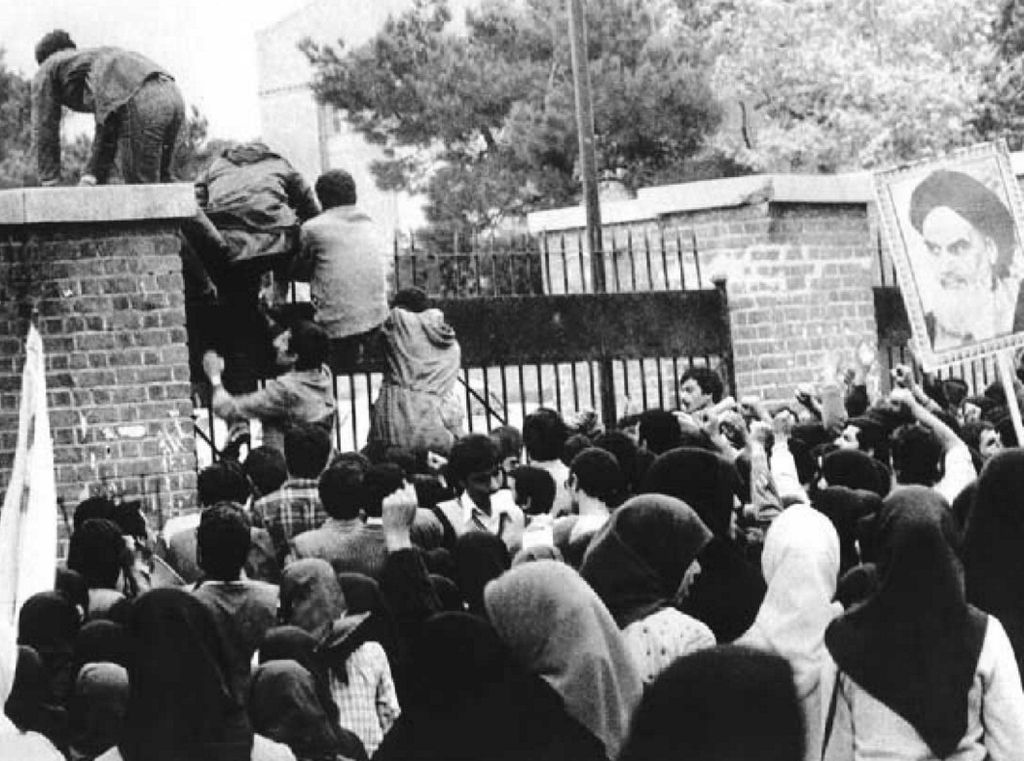 Primary Source: Photograph
Primary Source: Photograph
Iranian students carrying posters with a photograph of Khomeini climb the gate of the American embassy.
The Shah had escaped the Revolution and was in the United States receiving treatment for cancer. The revolutionaries demanded that he be returned to Iran in exchange for the hostages. President Carter refused, stating that the United States would “not yield to blackmail.” For 444 days, Americans watched helplessly as their fellow citizens were held in confinement. A rescue effort, entitled Operation Eagle Claw, ordered by President Carter failed in April 1980 when a helicopter and support plane crashed in the Iranian desert. Eight American service members and one Iranian died. It was an embarrassment for the American Special Forces and the President, who took responsibility for the failure.
Because of the hostage crisis, the failure of the rescue mission, and the struggling economy, Carter lost his bid for reelection to Ronald Reagan. It was one of the most lopsided elections in American history. While usually viewed by historians as a failed president, Carter worked tirelessly in his long post-presidency to promote human rights around the world, and is considered a great humanitarian.
In a final insult to Carter, the new Iranian government, a theocracy led by the nation’s clerics, released the hostages minutes after Ronald Reagan was sworn into office.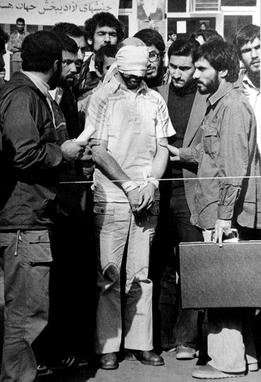 Primary Source: Photograph
Primary Source: Photograph
A photograph of American Barry Rosen released by the Iranians during the hostage crisis. Images such as these infuriated the American public who blamed President Carter for his inability to find a way to bring the hostages home.
THREE MILE ISLAND
The nation’s trust of its leaders and institutions took another hit in 1979 at the Three Mile Island nuclear power plant in Pennsylvania.
On March 28, a valve in the cooling system got stuck in the open position which allowed large amounts of nuclear reactor coolant to escape. In normal operation, the coolant would maintain safe temperatures inside the reactor. Without it, the reactor would overheat, melt, and spew out radioactive material. The mechanical failure was compounded by the failure of plant operators to recognize the situation due to inadequate training and design flaws that made control room indicators ambiguous. As a result, an operator mistakenly believed that there was too much coolant water present in the reactor and manually overrode the automatic emergency system.
By early the next morning it had become clear that things were going wrong. The temperatures inside the reactor were too high. The station manager announced a general emergency. The electric company that owned the plant, Metropolitan Edison (Met Ed) notified the Pennsylvania Emergency Management Agency, which in turn contacted state and local agencies Governor Richard L. Thornburgh. The uncertainty of operators at the plant was reflected in fragmented, ambiguous, or contradictory statements made by Met Ed to government agencies and to the press, particularly about the possibility and severity of an off-site release of radiation.
Lt. Governor Scranton held a press conference in which he was reassuring, yet confusing about this possibility, stating that though there had been a “small release of radiation…no increase in normal radiation levels” had been detected. These were contradicted by another official, and by statements from Met Ed, who both claimed that no radioactivity had been released. In fact, readings from instruments at the plant and off-site detectors had detected radioactivity releases, albeit at levels that were unlikely to threaten public health as long as they were temporary, and providing that containment of the then highly contaminated reactor was maintained.
Angry that Met Ed had not informed them before conducting a steam venting from the plant, and convinced that the company was downplaying the severity of the accident, state officials turned to the Nuclear Regulatory Agency (NRC), the federal agency charged with oversight of commercial nuclear power plants.
After receiving word of the accident from Met Ed, the NRC activated its emergency response headquarters in Bethesda, Maryland and sent staff members to Three Mile Island. NRC chairman Joseph Hendrie initially viewed the accident as a cause for concern but not alarm. However, the NRC faced the same problems in obtaining accurate information as the state, and was further hampered by being organizationally ill-prepared to deal with emergencies, as it lacked a clear command structure and the authority to tell the utility what to do, or to order an evacuation of the local area.
In the end, the United States was lucky. The reactor at Three Mile Island overheated and melted, but not so much that it breached the protective shell that surrounded it. However, the Three Mile Island accident showed once again that leaders, in business and technology, as well as in politics were not immune from mistakes and were not to be trusted to provide accurate, truthful information when the public’s safety was on the line.
The Three Mile Island accident also marked a significant turning point in the global development of nuclear power. The accident did not initiate the demise of the nuclear power industry, but it did halt its historic growth. At the time of the incident, 129 nuclear power plants had been approved for construction, but of those, only 53 were built. Clearly, many anti-nuclear activists argued, scientists and business leaders were willing to take shortcuts and nuclear power was too dangerous to be used as a source of electricity. Globally, the end of the increase in nuclear power plant construction came with the more catastrophic Chernobyl disaster in the Soviet Union in 1986.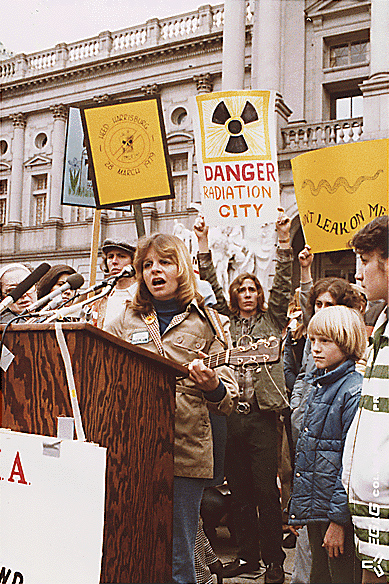 Primary Source: Photograph
Primary Source: Photograph
Anti-nuclear activists demonstrate outside the Pennsylvania State Capitol building after the Three Mile Island incident.
CONCLUSION
So, we learned from the 1970s that sometimes the people we elect to the most powerful positions of authority are imperfect. They make poor decisions. They try and to solve important problems and fail. Sometimes they lie and break the law to hide their lies. After the stringing disappointments of that decade, Americans have come to be much less trusting of our leaders.
What do you think? Should we trust our leaders?
CONTINUE READING
SUMMARY
BIG IDEA: The 1970s was a period when Americans lost faith and trust in their leaders. Politicians were exposed as liars. The economy failed and leaders were not able to repair the damage, and the celebrated American industrial economy started to crumble.
The 1970s were a time when some of America’s most important leaders failed. In the case of the Pentagon Papers, reporters revealed that the Presidents of the 1950s and 1960s had lied to the American people about their real reasons for fighting the war in Vietnam, and about how the war was progressing.
President Nixon was forced to resign in 1974 when it became clear that he had abused his authority in an attempt to hide crimes committed by his supporters. The Watergate Scandal, named after the Watergate Hotel and Office Complex, along with the Pentagon Papers, marked a change in America. After the early 1970s, many fewer Americans trust presidents and other powerful leaders.
In the later decade, President Carter faced his own challenges. Although he was not corrupt like Nixon, he was unable to solve significant problems. Most embarrassingly, revolutionaries in Iran held 52 Americans hostage. Carter could not negotiate their release and a military rescue mission failed.
A meltdown at the Three Mile Island nuclear power plant showed Americans that its top scientists, engineers and business leaders were also imperfect.
VOCABULARY
![]()
PEOPLE AND GROUPS
Daniel Ellsberg and Anthony Russo: Analysts who helped write the Pentagon Papers report and released it to the press.
The Plumbers: A group of criminals that worked for the Nixon reelection team. They tried to prevent leaks of secret information that might hurt the president, but their ineptitude ultimately led to Nixon’s resignation.
George McGovern: Democratic candidate for president in 1972. He was anti-war, but lost in one of the most lopsided elections in American history.
Committee to Re-Elect the President (CREEP): Group that worked to fundraise for Nixon’s reelection campaign and used underhanded and illegal methods to hurt his opponents.
G. Gordon Liddy: Lawyer for CREEP and aid in the Nixon White House. He planned the Watergate break in.
Bob Woodward and Carl Bernstein: Young reporters working for the Washington Post who uncovered much of the Watergate cover-up.
Deep Throat: Pseudonym for Mark Felt, Associate FBI Director who met secretly with Woodward and Bernstein and gave them information about the Watergate cover-up.
John Dean, H.R. Halderman, John Ehrlichman and John Mitchell: Aids to Nixon who lost their jobs and went to jail because of their involvement in the Watergate cover-up.
Archibald Cox: Special prosecutor appointed by Nixon to investigate the Watergate affair.
Alexander Butterfield: Minor White House official who revealed that there were secret recordings of Nixon’s conversations and telephone calls.
Gerald Ford: Vice President who became president after Nixon Resigned in 1974. He lost the 1976 presidential election to Jimmy Carter.
Ayatollah Ruholla Khomeini: Religious leader who led the Iranian Revolution and became the first leader of the theocracy.
![]()
KEY IDEAS
Impeachment: The Constitutional process of removing an elected official or judge. In the case of a president, the House of Representatives serves as the prosecutors and the Senate as the jury.
Obstruction of Justice: Charge that an official uses his or her authority to prevent investigation of a crime.
Theocracy: A system of government based on a particular religion in which religious leaders hold power in government.
Anti-Nuclear Movement: A movement to end the use of nuclear power for electricity production. Despite the fact that nuclear power produces almost no pollution, activists feared the potential for catastrophic accidents.
![]()
DOCUMENTS
The Pentagon Papers: Nickname for at secret report about the Vietnam War. It was released to the public and showed that the government and military had deceived the public about the progress of the war.
![]()
LOCATIONS
Watergate Complex: Office complex and hotel in Washington, DC. It was the location of the Democratic National Committee’s offices during the 1972 presidential election.
Three Mile Island: Nuclear power plant in Pennsylvania, and site of a nuclear meltdown in 1979.
Chernobyl: Nuclear power plant in the Soviet Union (Ukraine) that melted down in 1986, released large amounts of nuclear radiation.
![]()
EVENTS
Watergate Scandal: The name for all of the crimes, investigations and ultimate resignation of President Nixon associated with the Watergate break-in and subsequent cover-up.
Watergate Hearings: Hearings in 1973 in which the Senate tried to uncover the extent of the Watergate cover-up.
Saturday Night Massacre: Nickname for the day Nixon forced the resignation of his Attorney General and the firing of Archibald Cox. The event led many Americans to believe that Nixon was trying to hide his own wrongdoing.
Nixon’s Resignation: Nixon resigned the presidency on August 9, 1974. He was replaced by Vice President Gerald Ford.
Pardon of Nixon: President Gerald Ford pardoned Nixon for any and all crimes associated with the Watergate Scandal. This ended the possibility of an investigation and trial of the former president.
Iranian Revolution: Overthrow of the Shah of Iran in 1979 and establishment of the Islamic Republic.
Iranian Hostage Crisis: The 444-day holding of 52 Americans by the new revolutionary government of Iran.
Operation Eagle Claw: Failed attempt to rescue the American hostages from Iran. The mission embarrassed the military and President Carter.
![]()
SPEECHES
“I’m not a crook”: Famous claim by Nixon to the press during the Watergate Scandal.United States v. Nixon: 1974 Supreme Court case in which the court decided that the president could not claim executive privilege to hide evidence such as the recordings of his conversations.
![]()
COURT CASES & LAWS
New York Times Co. v. United States: 1971 Supreme Court case that granted the press wide latitude in publishing classified documents with the purpose of informing the public about government activities.
United States v. Nixon: 1974 Supreme Court case in which the court decided that the president could not claim executive privilege to hide evidence such as the recordings of his conversations.
25th Amendment: Constitutional amendment providing a method for replacing the Vice President.

If I was Nixon then I would have told the truth and told people that I was not unaware of the break in. It was unnecessary to cover it up when people did not think Nixon was a part of it in the first place.
With all these presidential scandals being revealed, I wonder just how many other presidents or politicians lied to the public but got away with it.
I find that the nuclear power plant in Pennsylvania connects back to the marshall islands nuclear testing which was yet 1000 times bigger than hiroshima. If it had continued to increase power, then more damage would have been caused to those testing sites which in itself was bad enough already.
What happened to the people that were caught breaking into the Watergate Complex? Did Nixon take the blame or help them?
If Nixon had exposed Watergate instead of trying to hide it, since technically he had nothing to do with the break-in, would his popularity have gone up and would have been guaranteed reelection anyway?
What if the CREEP group didn’t get caught and Nixon won his presidency?
Has any other member of government tried to do something similar to the Watergate Scandal to win?
Is the government hiding more stuff from the public that is too dark to know?
Did Ronald Raegan only win because of Carter’s failures?
Did Nixon ever try to recover his reputation?
Why did Ford pardon Nixon?
Could there have been other moments in history that we have been lied to, but never revealed the truth?
I found the website that allows you to download and read the actual Pentagon Papers.
Link: https://www.archives.gov/research/pentagon-papers
Were there any other events similar to the Watergate Scandal that made people not trust their leaders even more?
in general there were definetly more incidents that made the naiton not trust the government. like what happened with the three mile island or even Fords pardon.
What if Nixon didn’t say his famous claim “I’m not a crook,” do you think views of him would have changed a little?
I believe that the public view of him still would have changed but not so much as it did after Nixon preached that he was not a crook. The fact that one of our Presidents’ confidently opposed the rumors about him during a speech just for them to be true, is a little funny since he was exposed afterwards.
Is the outcome of the Iranian Hostage Crisis still affecting America’s morale to this day?
How big of an impact did Chernobyl make? And if it were to happen today, do we have something that can help to suppress it?
Through this whole section I was constantly thinking about the trust we have in leaders in our country and world. For me I wanted to find out more about the power of those in America and the trust that the general public had in them. I found this article that talks about the power of Presidents during the times between President Kennedy all the way to the Presidency of Obama. This is a very interesting time period and some may call this a turbulent time. Here is the link to the article for all those interested in learning about the power shifts.
Link: https://www.smithsonianmag.com/history/power-and-the-presidency-from-kennedy-to-obama-75335897/
Learning about today’s reading of presidential scandals, makes me really wonder how much the government is keeping secrets from us and how much we really don’t know about anything
Same, our nation has a history of covering up quite “dark” parts of our history even with the Freedom of Information Act. Things like area 51, Jeffery Epstein, and even the false missile alert makes me wonder how much we ACTUALLY know.
What impact has the Watergate scandal had on presidential power throughout time?